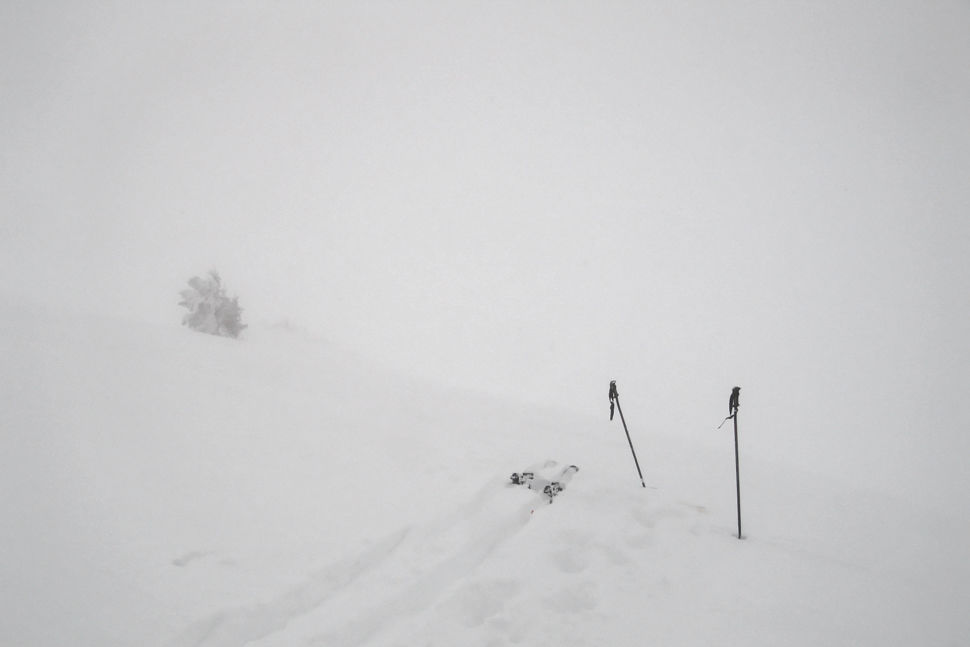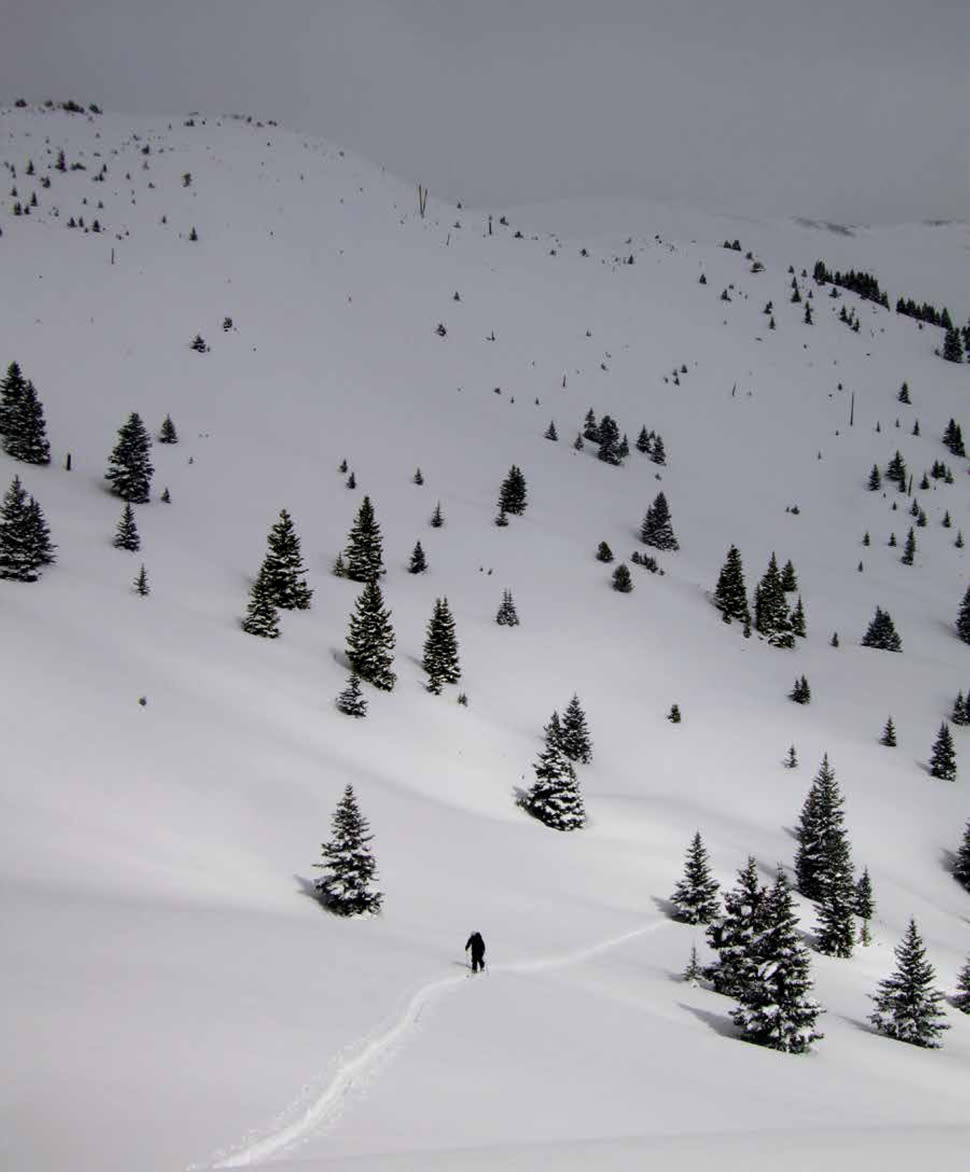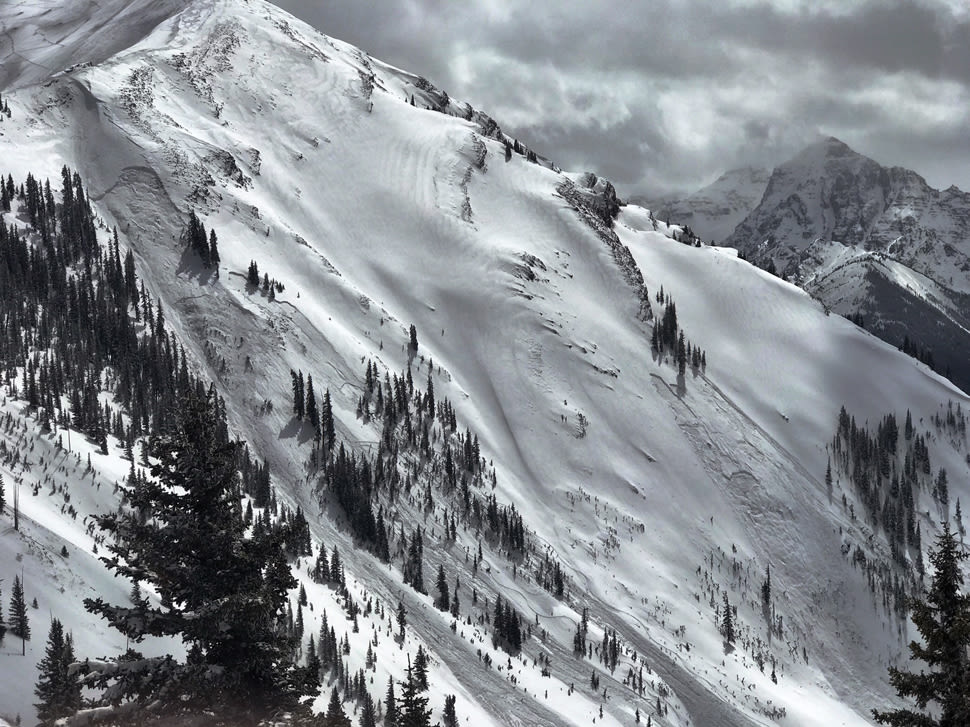
Let's Open up the Conversation About Avalanche Awareness

Crossing suspect slopes one at a time is part of avalanche safety protocol.
Image: Ross Kribbs
When four locals set out to ski a line near Independence Pass one beautiful March day, they thought they were well prepared. Deeply experienced in the backcountry, they had been exploring the area and had skied an adjacent slope the day before. They designated a leader, identified a seemingly safe uphill route alongside some trees, and formulated an escape plan for the ski down. Their chosen line: an open face with a slope angle of 32 degrees—under the 35-degree threshold that usually signifies heightened avalanche danger.
In hindsight, however, “we hadn’t looked at the big picture,” says one of the four, Arabella Beavers, an accomplished snowboarder and skier who at the time was also a member of Mountain Rescue Aspen. Red flags included signs of wind affect, including a large cornice at the top of the slope.
The group had just gotten above tree line when one member stepped out of the skin track. They heard a “whoomph” as the snow above them settled, then saw what Beavers describes as little puffs of smoke. After calling out to the others to head for the trees, she latched tightly onto a trunk, feeling the “incredible pressure” of the snow bearing down. The group leader’s ski came off as he turned around to reach the trees, and he got caught in the slide.
“I’m hit!” Beavers remembers him screaming, as she yelled at him to swim.
She held onto the tree while what felt like “a howling hurricane” came through, with powerful waves of snow trying to pull her under. “It seemed like forever, but it was probably one minute, max,” she says.
When the avalanche stopped, three of the group confirmed they hadn’t been caught. The group leader, who had been swept down a few hundred feet, was partially buried yet still able to communicate. But another wave of snow soon followed, carrying him an additional 200 feet downslope, where he was tossed against a small tree and broke his leg. Ironically, this may have saved his life, says Beavers, because it prevented him from being swept down farther and most likely fully buried.
Facing the possibility of more snow breaking loose, the friends raced the clock to get the injured skier to medical help. After picking their way down through the trees to reach their partner from a safer spot below him, they carefully dug him out, fashioned a crude leg splint, and lowered him on a snowboard to their snowmobile. Says Beavers, “Nobody prepares you” for the challenging, painful descent through avalanche debris—rock-hard snow clumps riddled with broken pieces of trees—exacerbated by the stress of the situation.
Between their calm, methodical approach and some heroic maneuvering, everyone made it out safely, and the group leader’s leg was successfully treated—luckily the group’s only physical injury. But the incident would gradually take its toll psychologically. Two years later, after an uneventful ski tour in the same area, Beavers quit backcountry skiing.
Looking back, she assigns no blame to any one member of the group for what happened that day, yet she acknowledges the friends might have mitigated their risk by more thoroughly assessing the hazards. “The only thing we did wrong was step out the door that morning,” she says.
With backcountry use on the rise, scenarios like the one experienced by Beavers and her friends are more apt to take place. In response, backcountry awareness training has progressed, too, with a new emphasis on risk evaluation and sound decision-making—in other words, the human factor.
Avalanche education in the United States has existed since the 1950s, according to Brian Lazar, deputy director of the Colorado Avalanche Information Center (CAIC). But it wasn’t until the 1990s, when the Colorado-based American Institute for Avalanche Research and Education (AIARE) was founded, that standardized, best practices-based curricula for courses were developed to better meet the needs of professionals and the recreational public.
Up until relatively recently, those courses heavily emphasized snow science: digging pits and measuring snow crystals, for example. “But not all that content was helping people make better decisions,” says Lazar.
A former executive director of AIARE who has guided, taught, and developed curricula in the field for decades, Lazar says that backcountry education programs have evolved, adding tools “that help manage our pitfalls as human beings.” These include steps like reading avalanche forecasts and trip planning, developing comprehensive awareness in the field, and using checklists as part of a structured decision-making process—the latter adapted from similar procedures in the medical and airline industries, other potentially high-risk environments.
Checklists, in particular, can help skiers avoid the complacency that often comes with familiarity. Lazar cites the experienced backcountry skier who frequents the same area. It can be tempting, after dozens of positive outings, to not thoroughly evaluate conditions. But that’s exactly when one might overlook important changes that could affect snow stability. “That’s what checklists are there for,” says Lazar, using the analogy that “99 times out of 100, the surgeon is not going to sew up the scalpel in the patient.”
As the programs incorporate new technology and findings, something seems to be working, Lazar adds; the avalanche fatality rate has remained relatively flat despite an explosion in backcountry use the last few years. That’s notable in Colorado, where the notoriously unstable snowpack accounts for one-third of all US avalanche deaths since 1950, and particularly in Pitkin County, which leads the state (and therefore the country) in avalanche fatalities, according to CAIC data. Why? Backcountry use may be greater in busy counties near the Front Range, says Lazar, but in Pitkin County, skiers are tempted by steep, avalanche-prone terrain that’s easily accessible from the resorts—again, the human factor at play.
Native Aspenite Mike Marolt had no formal avalanche education well into his ski mountaineering career. Mostly he and his twin brother, Steve, relied on their father’s “25” rule. As he explains, “At 25 degrees [and under], you’re safe. If it’s warmer than 25 degrees, you’ve got to know the snowpack. And more than 25 centimeters of new snow needs 25 hours to settle.”
The brothers confronted the human factor head-on in Alaska’s Wrangell–St. Elias National Park in the early 1990s. Having climbed and skied what Marolt called an “incredibly stable snowpack” for five days, they were joined on the last day by a local bush plane pilot who knew the area well.
As soon as the trio stepped out of the plane onto a glacier, Steve remarked that the snow felt different—a crust had formed that he didn’t trust. But the pilot insisted everything was fine and took off, forcing the brothers to follow. The higher they climbed up the peak, the more excited they got about skiing its pristine, steep face. And the snow did feel better as it got colder.
Mike Marolt was the second to go. Watching the pilot ski down the “endless slope of big, soft pillows of beautiful powder, all common sense went out the door,” he says. He jumped in, made a few turns, and found himself waist deep in a pillow of snow—with vertigo and a sick feeling in his stomach.
The entire face fractured and began to slide. Marolt calmly realized his only chance was to ski out of it. Somehow, he gained enough momentum to do so by riding the back of a wave of snow, then skirted over to a ridge for safety.
What went wrong? “We let our guard down,” he says. “We didn’t stick with our hard and fast rule, which was following our gut.” But that near miss was the best avalanche lesson he’s ever had, Marolt adds. “It changed the way I backcountry ski, climb, cross the street, drive my car.”
Choosing to reduce his risk exposure, he only skis the Colorado backcountry in the spring when the snowpack has consolidated, defers to the most conservative approach in the group, and carries a notebook in which he’s pre-written the ideal scenario of the outing. If even one element is off, so is the climb or ski.
Marolt’s near miss also spurred him to study brain science. He learned about the power of emotion relative to rational thinking. It’s not that education and experience breed overconfidence, he explains. Rather, “your emotional vortex will almost always override intelligence, no matter how educated you are.” Thus, he uses his scenario notebook to trigger the rational part of his brain.
A similar focus on rational decision-making appears in new videos from Backcountry Access, known for products like avalanche beacons and airbags. The BCA Safe Shredding Series tweaks traditional “ski porn” by showing backcountry users going through the decision-making process and taking precautions before riding virgin powder.
And avalanche education has incorporated recognizing common human pitfalls, or “heuristic traps,” and their potential to sabotage safe decision-making in the backcountry. Known by the acronym FACETS, these pitfalls are: familiarity, acceptance, consistency, expert halo, tracks (as in first), and social facilitation.
Essential to learning more about the human factor is sharing and discussing close calls and fatalities, but secrecy due to guilt, shame, embarrassment, and fear of being judged is fairly common around avalanche incidents. Marolt didn’t speak about his near miss for 20 years. “It’s the ultimate mistake that sends the signal that I have no clue what I’m doing out there,” he says.
Arabella Beavers was urged not to talk publicly about her group’s close call on Independence Pass; those she did tell weren’t as supportive as she hoped they’d be, and some were quite judgmental. “We need to change what happens in the aftermath,” she believes. “We should be able to tell people what we saw, what went wrong, what may save your life if you find yourself in that situation.”

At far right side, the slide in Maroon Bowl that caught two skiers last April as they were ascending the slope. The slides at left were triggered by explosives.
Last April, an avalanche in Maroon Bowl, typically accessed from Aspen Highlands ski area, killed John Galvin, a 30-year veteran of Mountain Rescue Aspen (MRA), and lightly injured his backcountry ski partner. The surviving skier, a former MRA member who no longer resides locally, has not been publicly identified, although there’s widespread curiosity to gain first-person insight into the accident from a backcountry professional. Then, in late November, another sidecountry avalanche fully buried an Aspen Powder Tours employee (not during a Powder Tours trip, though). His colleague dug him out unharmed; neither have been able to speak publicly about it. Both incidents occurred during spikes in avalanche danger after storms had moved in, prompting many in the community to question the skiers’ decision-making process.
CAIC’s Lazar responds to such questions without judgment. People simply have different levels of risk acceptance, he says, which may lead them to knowingly face hazards in the backcountry.
MRA, meanwhile, which some consider a secretive organization in and of itself, has started to peel back the curtain with a ramped-up public education program. A new event on April 5 that will feature survivors of backcountry accidents telling their stories is intended to remove the stigma associated with those situations. “We need to make it not about shame, but about learning,” says MRA’s Greg Shaffran, who is also an avalanche course instructor and backcountry guide.
Moreover, the organization’s annual introductory backcountry awareness class has expanded to focus largely on companion rescue, including elaborate practice scenarios. These and other educational events are being added because “people are thirsty for it,” says Shaffran, whose avalanche courses are now always full. “It’s not cool to go out into the backcountry without education anymore.”
After the high-profile avalanche deaths of two US Ski Team athletes in 2015 while freeskiing in Austria, the Bryce and Ronnie Athlete Snow Safety Foundation (BRASS) was born, specifically to address the need for a more comprehensive and open culture of avalanche education. Last fall, BRASS produced and distributed a 13-minute video, Off Piste: Tragedy in the Alps, that re-creates the accident and attempted rescue, and conveys backcountry safety tips with a unique and powerful delivery.
Carbondale resident Lou Dawson knows firsthand that a wealth of technical knowledge doesn’t necessarily correspond to safety. Dawson—a lifelong mountaineer and backcountry skier whose Wild Snow blog is a well-respected, in-depth resource—was 30 years old, with an already impressive résumé of professional guiding and other experience, when he got caught in a life-changing avalanche.
His account on Wild Snow of the 1982 incident in then-closed Highland Bowl—which resulted in a life-threatening broken femur, hypothermia, and two-week hospitalization—viscerally describes the event. Propelled by ego and confidence in his backcountry skills, Dawson writes that he had “lost my fear and replaced it with downright stupidity” in bypassing precautions to satisfy his lust for the Bowl’s most extreme line.
But it’s too simplistic to ascribe his accident to one human factor. He describes the pursuit of backcountry snow sports as a constant management of risk. “If you choose this sort of sport, as I have, you stay alive by using elaborate safety systems,” writes Dawson. “…But human beings being what we are—proud, competitive, impatient—we sooner or later make a mistake. On top of that, risk sports give you feelings of invincibility. You come back alive, and you know hubris.”
A study presented at the International Snow Science Workshop in Austria last fall, says Dawson, found that those who take avalanche courses are by nature sensation-seekers and thus more prone to getting into trouble. The study’s author suggested that all avalanche course participants should take the personality assessment to determine their risk-taking factor, then use the results when determining backcountry behavior and goals.
After his accident, Dawson, too, dialed back his level of risk acceptance, choosing lower-angle slopes and using more caution in the backcountry. But not everyone should learn by fire. As human factors receive more attention in avalanche awareness programs, it’s increasingly up to skiers and riders to decide how best to apply their knowledge and experiences.
Or, as Dawson has simply concluded, “I try to play by the mountain’s rules instead of mine.”
Higher Learning
Help mitigate your own backcountry risk and practice decision-making, along with learning or brushing up on avalanche awareness basics, with a course from a local guide service.
Aspen Expeditions offers the one-day American Institute for Avalanche Research and Education (AIARE) Companion Rescue Course ($165) on Feb 20 and Mar 7, and the three-day AIARE Level 1 Course ($420) Mar 1–3, 8–10, 15–17, and 18–20; and April 1–3, 5–7, and 12–14. A four-day Level 2 Course ($685), which includes a day focused on big-mountain terrain, takes place Mar 21–24. Custom dates can also be booked.
Aspen Alpine Guides, in partnership with the 10th Mountain Division Hut Association, teaches a three-day AIARE Level 1 Course ($475) at the Sangree M. Froelicher hut outside Leadville Feb 28–Mar 3, and Level 1 Courses in Aspen ($395) Feb 15–17 and Mar 22–24. A one-day AIARE Companion Rescue Course ($145) is offered Mar 10; call for dates of the four-day Level 2 course ($525).
Mountain Rescue Aspen’s free Apr 5 panel on backcountry safety takes place at 6 p.m. at the CB Cameron Rescue Center (37925 Hwy 82).














































